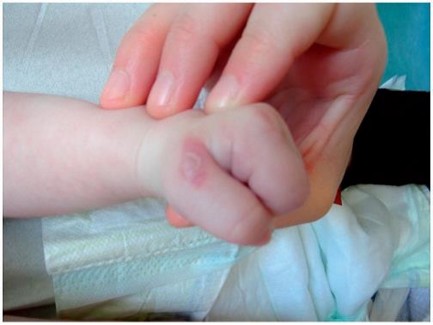(Bloch-Sulzberger Syndrome, Bloch-Siemens syndrome)
Prevalence: around 0,7/100 000. Sporadic cases or X-linked dominant transmission of a mutation of the NEMO gene, nowadays known as IKBKG (NF-κB essential modulator) (Xq28). Rare multisystemic ectodermal dysplasia usually lethal in boys, except in case of 47 XXY. Characterized by a combination of cutaneous manifestations of neonatal onset and resulting in hyperpigmentation before 1 year of age.
The dermatosis evolves into 4 stages:
1) erythematobullous (first weeks): vesicobullous erythema, following the Blashko lines on the limbs, swirled on the scalp;

2) verrucholichenoid (2 to 8 weeks of age): hypertrophic, warty or lichenoid lesions.
3) pigmentary (from 6 to 12 months of age until aduldhood): special layout (swirls, water jets) or linear, better seen under Wood's light
4) involutive (aduldhood): disappearance of pigmented plaques and appearance of achromic zones.
Alopecia and nail dysplasia can also be present.
There are extracutaneous lesions in 50-80 % of cases:
- eyes (35 %): corneal opacities, cataract, uveitis, nystagmus, retinal detachment, optic atrophy
- central nervous system (30 %): pyramidal syndrome, cerebellar ataxia, mental retardation, epilepsy (30 %), cerebral vascular accidents
- teeth: partial anodontia, caries, high-arched palate, sometimes cleft palate
- rare: heart disease, a few cases of rapidly fatal pulmonary hypertension, facial hemiatrophy
There is a predisposition to retinoblastoma, nephroblastoma and myeloid leukemia.
Anesthetic implications:
eye protection. Fragile skin in the areas involved by the dermatosis.: avoid any adhesive dressing and prefer silicone dressings. Difficult peripheral venous access. Specific anesthesia of an epileptic child; echocardiography. Risk of difficult intubation (teeth). Corticotherapy.
References:
- Yasuda K, Minami N, Yoshikawa Y, Taketani T et al.
Fatal pulmonary arterial hypertension in an infant girl with incontinentia pigmenti.
Pediatr Internat 2016; 58 : 394-7
- Batson R, Keeling BH, Diaz LZ.
Incontinentia pigmenti.
J Pediatr 2016; 176: 218.
- Atallah V, Meot M, Kossorotoff M, Galmiche-Rolland L et al.
A case of reversible pulmonary hypertension associaed with incontinentia pigmenti.
Pulm Circulation 2018; doi : 10.1177/2045894018793983
- Sugur T, Kavakli AS,Metiyurt HF.
Anaesthesia and orphan disease :a child with incontinentia pigmenti.
Eur J Anaesthesiol 2020 ; 37 : 141-3
- Glade DC, Sitabkhan AZ, Osswald SS.
Spreading vesicles in a neonate.
J Pediatr 2020 ; 219 ; 275-6.
- Baig SM, Shah SP.
The anesthetic challenges of caring for a pediatric patient with incontinentia pigmenti.
A&A Practice 2021; 15:e01384
Updated: February 2021